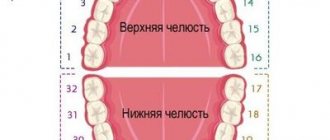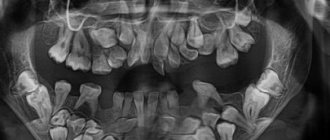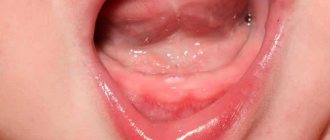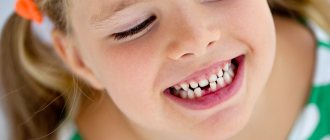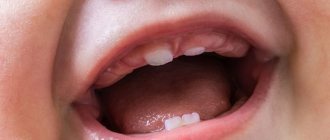How many baby teeth do children have?
Milk teeth and even some molars begin to form at the stage of intrauterine development. Of course, a child has no visible teeth at birth - they begin to erupt only after 6 months. During this six-month period, they are hidden under the gums, but slowly develop and form, beginning to move outward.
In total, a child grows 20 baby teeth:
- Central and lateral incisors – 8.
- Fangs – 4.
- First and second molars – 8.
Their main function is to form a space where molars will then grow.
How to make teething easier
By six months, when teeth usually make themselves felt for the first time, the immunity the baby received during pregnancy and breastfeeding weakens. The first colds and acute respiratory infections appear, the functioning of the intestines and stomach is upset. The process, painful in itself, becomes more complicated. Parents may observe the following symptoms:
- refusal to eat due to sore gums;
- cough caused by excess saliva;
- swelling in the gum area, pain;
- anxiety, poor sleep;
- temperature up to 38–39 degrees.
The baby begins to feel the need to get rid of unpleasant sensations; he tries to put any object he can reach into his mouth. During this period, it is important to ensure the sterile cleanliness of toys, pacifiers and bedding so that the child does not become infected. Keep the lower part of your face clear of saliva, otherwise irritation may occur.
According to many mothers and pediatricians, the baby’s condition is best facilitated by the use of refrigerated teethers. Modern models are safe, fit comfortably in a baby’s hand, and can be sterilized.
You can give your baby a piece of carrot or hard fruit only if he has no teeth. Cookies, crackers and dry goods are excluded - the baby may choke. They can be offered to your toddler when he approaches the age of two years.
Medicines prescribed by your pediatrician, based on paracetamol or Ibufen, will help reduce your temperature. Depending on the age, the child is given syrup or candles. If there is no fever, it is enough to wipe the baby with a wet diaper. If the thermometer readings begin to rise, it is better to call an ambulance.
Relieves itching in the gums and teething with a light massage. When using gels and ointments to reduce gum sensitivity, check to see if they contain lidocaine. This substance briefly relieves the symptoms of toothache, but can have a bad effect on heart function. Homeopathic medicines help some children.
Provide the baby with favorable conditions: air, cleanliness and coolness.
Important. The use of any medications at such a tender age should be strictly agreed with the pediatrician.
How many teeth does your child have at 2 years old?
- From 16 and over 50%, 504 votes
504 votes 50%504 votes - 50% of all votes
- From 10 to 16 42%, 419 votes
419 votes 42%
419 votes - 42% of all votes
- From 4 to 10 6%, 57 votes
57 votes 6%
57 votes - 6% of all votes
- From 0 to 4 1%, 7 votes
7 votes 1%
7 votes - 1% of all votes
- All 20...*1%, 5 votes
5 votes 1%
5 votes - 1% of all votes
- Z*0%, 4 votes
4 votes
4 votes - 0% of all votes
- None 0%, 3 votes
3 votes
3 votes - 0% of all votes
Total votes: 999
14.08.2018
×
You or from your IP have already voted.
How many teeth should a child have per year?
During this period, baby teeth begin to cut.
They begin to break out in the following sequence on the upper and lower jaws. On the top:
- 8-12 months. Central incisors.
- 9-13 months. Lateral incisors.
- 16-22 months. Fangs.
- 13-19 months. First molars.
- 25-33 months. Second molars.
In the lower jaw, this process is distributed in time somewhat differently:
- 6-10 months. Central incisors.
- 10-16 months. Lateral incisors.
- 17-23 months. Fangs.
- 14-18 months. First molars.
- 23-31 months. Second molars.
It is worth noting that these time limits are averaged and deviations up or down by 1-3 months are considered normal.
If you want to know how many teeth a child has per year is considered normal, you should refer to the chart described above. You get that at the age of 12 months there should be 6-8 of them.
Cutting speed
At first, parents wait impatiently for the first tooth, examining the baby's gums for restless behavior. When the incisors begin to erupt one after another, it is rare for a baby to tolerate this process calmly. Moms and dads often want to speed it up, but little depends on them. The speed of teething is affected by:
- features of hereditary predisposition;
- the state of the endocrine system of the baby and mother during pregnancy;
- the state of the environment in the area of residence;
- state of the immune system;
- period of appearance of the first incisor;
- infectious diseases and rickets;
- supply of nutrients to the body.
Interesting fact. Often teeth appear early in firstborns and children of late-parous parents. The most problematic one is usually the first tooth.
Changing baby teeth to molars
Around the age of 4, a child’s growth spurt begins, the jaws enlarge and the baby teeth seem to move apart, with gaps appearing between them – trema. If this does not happen and by the age of 5 the teeth are still tight, you need to show the child to the dentist, as there may not be enough space for permanent teeth.
At about 5-6 years of age, baby teeth begin to become loose and gradually fall out, which indicates that the molars are already beginning to grow underneath them. Usually this process of change lasts for 5-8 years and the final formation of the dentition occurs somewhere around 14-15 years.
This happens in the following order:
- 5-6 years – lower and upper incisors.
- 7-8 years – lower and upper lateral incisors.
- 8-10 years – upper and lower molars.
- 9-11 years – upper and lower canines.
- 11-13 years – upper and lower molars.
Milk teeth are replaced by permanent molars. Their number at the age of 14-16 years is 28. At the same time, the third molars (wisdom teeth) are already formed, but they begin to grow only after 18 years. True, not all people grow them. It all depends on individual characteristics.
Signs that teeth are being cut
Many young parents do not immediately understand the reason for this child’s behavior and come up with terrible diagnoses before the doctor explains to them what the problem really is. But how not to confuse teething with illness or discomfort of the baby? At what age does the first tooth begin to cut? What to do to ease the baby's suffering? All this will be discussed below. Before the first teeth erupt, the baby feels discomfort, so he constantly tries to massage the gums with “improvised objects”
All babies experience the eruption of their first teeth differently: some go through this period steadily and relatively painlessly, while others suffer and suffer. It is difficult to explain what this difference depends on, but we can say with certainty that not a single newborn has had an absolutely comfortable teething process.
How can parents determine that their baby has started teething? There are several symptoms that are most common.
- The baby's salivation increases, he begins to move his jaws more often, as if he is trying to chew something or massage his gums.
- The child becomes more excitable, he may cry more often for no reason, be capricious, sleep poorly, and sometimes refuse to eat.
- An increase in body temperature also indicates the appearance of the first teeth.
- The baby may have diarrhea.
- The gums become swollen and red, and itching appears. If such symptoms are present, the baby more often touches his mouth with his hands, tries to stick his fingers into it, and rubs his cheeks.
- Teething is often accompanied by a weakened immune system. Against this background, the baby may develop a cough or runny nose.
The formation of teeth in humans begins several months before birth. For example, baby teeth are formed in a baby in the fourth month of the mother’s pregnancy, and then (the fifth and sixth months) the molars are formed.
How many teeth should a child have?
It all depends on age. The maximum number of teeth in the period from birth to 5-6 years is 20 - these are milk teeth. Then, until the age of 15-16, the molars begin to erupt, pushing out the milk teeth. Ultimately, their number grows to 28.
The latest are the third molars. They grow only after 18 years of age, but not everyone has them.
It is worth noting that the period of formation and eruption of baby teeth is very individual. In some children, all 20 teeth grow by the age of 2, while in others - by 2.5 or later. Such delays within a year are considered normal and are not a developmental anomaly.
If teeth do not start cutting in the first year of the baby’s life, you should consult a doctor to find out the reasons.
To the list of posts
Features of the period and symptoms of the eruption of the first teeth.
DATES OF TEETHING ARE INDIVIDUAL FOR EACH BABY AND DEPEND ON A NUMBER OF FACTORS: NUTRITION, HEREDITY, ETC. THIS IS WHY YOU SHOULD NOT WORRY MUCH IF THE LONG AWAITED APPEARANCE OF YOUR FIRST TEETH IS DELAYED.
PHOTO: Gums of a child at 6 months. Before the first baby teeth erupt, the gums in the area of the future teeth turn slightly white due to tooth pressure.
It's hard to miss when children's first teeth appear. As the tooth erupts, it “tightens” the mucous membrane (the tooth can be felt with your finger under the mucous membrane) and, having “broken through” it, ends up in the oral cavity. In some children, a bluish “bump” or “ball” with transparent contents forms on the mucous membrane above the erupting tooth. This is a small eruption cyst that usually breaks out on its own WITHOUT outside help (despite the menacing name), although sometimes the intervention of a pediatric dentist is required.
The first teeth that appear may be located asymmetrically and “not evenly” - this is the norm. Such dental disorder has the right to exist until the eruption of 16 teeth: baby teeth are independently ordered as they erupt, aligning each other. This is facilitated by the intake of solid food, pressure of the tongue and lip muscles.
In a normal primary occlusion, gaps form between the primary incisors and canines (on average 1 mm), which is normal and a sign that the permanent wider incisors will have enough space in the dentition during the period of physiological change of teeth. The absence of these spaces indicates a lack of space for permanent teeth.
In most cases, teething does not cause the child any discomfort, although sometimes the process of teething can be accompanied by “itching” of the gums and lead to sleep disturbances in the child, causing a lot of trouble for the child and his parents.
Why don't teeth grow?
The absence of at least one tooth by the age of one year should cause concern on the part of parents. The anomaly may be associated with malfunctions of internal organs or serious diseases, indicating:
- lack of calcium, vitamin D;
- intestinal problems;
- infections;
- improper metabolism;
- malfunction of the thyroid gland;
- distorted arrangement of teeth in the gums (horizontal, with a slope);
- edentation - a congenital mutation indicating the absence of dental germs.
More often, delayed eruption is associated with heredity. Ask your grandparents about how many teeth you had in childhood, find an outpatient card, entries in development diaries. If by the age of one year the father or mother was toothless, then there is no need to wait for their baby to have dental dentition soon.
If at 1 year of age the child has no teeth and there are no signs of early teething, consult a doctor to identify diseases and analyze the medical history.
To exclude congenital edentation, an x-ray examination is performed. The picture shows the rudiments of baby teeth and molars awaiting their turn. If a serious illness is diagnosed, the baby will have to have breast augmentations or implants inserted.
Interesting fact! According to research by pediatricians, girls develop teeth faster than boys.
Useful tips
The root cause of diseases affecting the baby’s oral cavity is the incorrect actions of parents. To avoid problems such as caries, fluorosis, and enamel hypoplasia in the future, the following recommendations must be followed:
- For any abnormalities, make an appointment with your child to see a doctor.
- After teeth emerge, clean them with a special baby brush that fits on your finger.
- After 2 years, teach children to brush their teeth independently under adult supervision.
- For very small babies, brush their teeth with a weak soda solution or just with a damp brush. A 2-year-old child can brush his teeth using toothpaste.
- Buy a toothbrush according to your age group. The same goes for pasta.
- Brush your teeth with gentle movements without pressure.
- Choose fluoride-free baby toothpastes.
Folk remedy. You can gently clean children's teeth from pathogenic microflora with propolis infusion, a water-salt solution, or a decoction of sage or chamomile.


